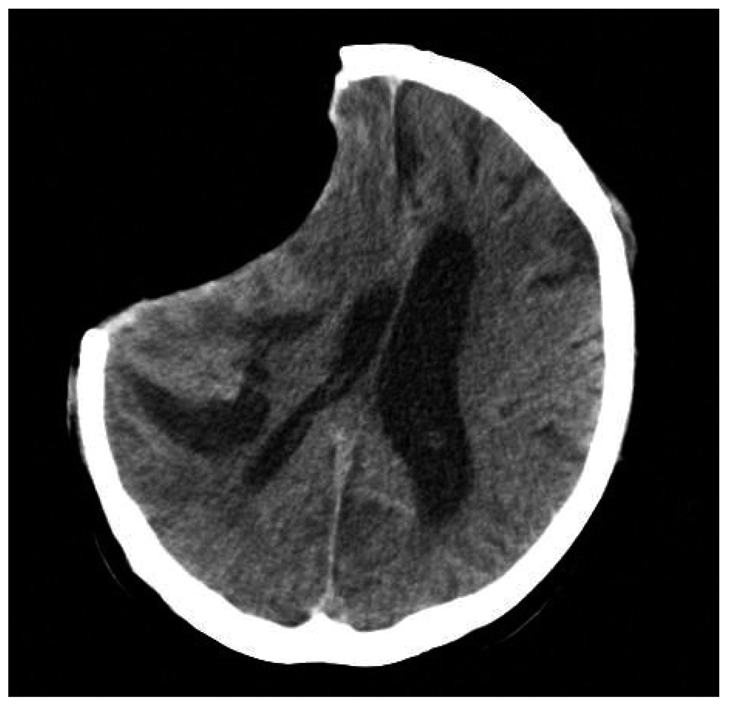J Korean Neurosurg Soc.
2012 Feb;51(2):117-119. 10.3340/jkns.2012.51.2.117.
Reperfusion Injury after Autologous Cranioplasty in a Patient with Sinking Skin Flap Syndrome
- Affiliations
-
- 1Department of Neurosurgery, Hanyang University Guri Hospital, Hanyang University College of Medicine, Korea. cjh2324@hanyang.ac.kr
- KMID: 1441423
- DOI: http://doi.org/10.3340/jkns.2012.51.2.117
Abstract
- The sinking skin flap syndrome is a rare complication after a large craniectomy. It consists of a sunken skin above the bone defect with neurological symptoms such as severe headache, mental changes, focal deficits, or seizures. In patient with sinking skin flap syndrome, cerebral blood flow and cerebral metabolism are decreased by sinking skin flap syndrome, and it may cause the deterioration of autoregulation of brain. We report a case of a patient with sinking skin flap syndrome who suffered from reperfusion injury after cranioplasty with review of pertinent literature.
Figure
Cited by 2 articles
-
Intracerebral Hemorrhagic Infarction after Cranioplasty in a Patient with Sinking Skin Flap Syndrome
Jai-Hyuck Han, Mou-Seop Lee
Korean J Neurotrauma. 2016;12(2):152-155. doi: 10.13004/kjnt.2016.12.2.152.Unexpected Severe Cerebral Edema after Cranioplasty : Case Report and Literature Review
Gwang Soo Lee, Sukh Que Park, Rasun Kim, Sung Jin Cho
J Korean Neurosurg Soc. 2015;58(1):76-78. doi: 10.3340/jkns.2015.58.1.76.
Reference
-
1. Cecchi PC, Rizzo P, Campello M, Schwarz A. Haemorrhagic infarction after autologous cranioplasty in a patient with sinking flap syndrome. Acta Neurochir (Wien). 2008; 150:409–410. discussion 411. PMID: 18246457.
Article2. Cho H, Kim CH, Kim JH, Kim JM. Paradoxical herniation after decompressive craniectomy for acute subdural hematoma. J Korean Neurosurg Soc. 2006; 40:51–53.3. Gooch MR, Gin GE, Kenning TJ, German JW. Complications of cranioplasty following decompressive craniectomy : analysis of 62 cases. Neurosurg Focus. 2009; 26:E9. PMID: 19485722.4. Isago T, Nozaki M, Kikuchi Y, Honda T, Nakazawa H. Sinking skin flap syndrome : a case of improved cerebral blood flow after cranioplasty. Ann Plast Surg. 2004; 53:288–292. PMID: 15480019.5. Richaud J, Boetto S, Guell A, Lazorthes Y. [Effects of cranioplasty on neurological function and cerebral blood flow]. Neurochirurgie. 1985; 31:183–188. PMID: 4033856.
- Full Text Links
- Actions
-
Cited
- CITED
-
- Close
- Share
- Similar articles
-
- Intracerebral Hemorrhagic Infarction after Cranioplasty in a Patient with Sinking Skin Flap Syndrome
- "Syndrome of the Sinking Skin-Flap" Secondary to the Ventriculoperitoneal Shunt after Craniectomy
- Bilateral Multiple Intracerebral Hemorrhagic Infarction after Cranioplasty in a Patient with Cerebral Infarction: Case Report
- Review of Cranioplasty after Decompressive Craniectomy
- Sinking Skin Flap Syndrome after Craniectomy in a Patient Who Previously Underwent Ventriculoperitoneal Shunt




